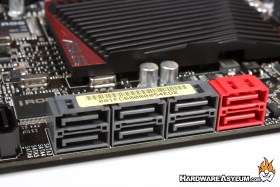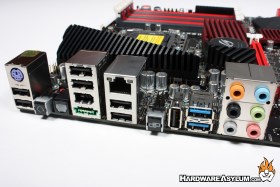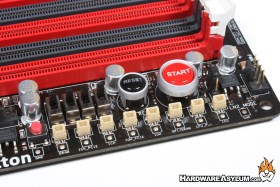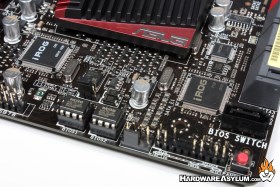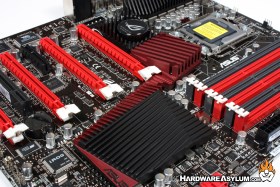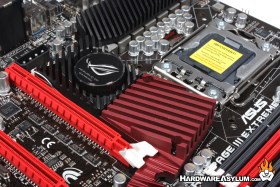Asus Rampage III Extreme Motherboard Review
Author: Dennis Garcia
Published: Saturday, March 05, 2011
Board Layout and Features Cont.
There are no IDE ports on this motherboard and to make up for it you'll find a total of 10 SATA connections. Six SATA2 connections come direct from the south bridge, two SATA3 ports are provided by an onboard Marvell controller and the remaining 2 are part of a JMicron controller tasked with providing eSATA.
The I/O panel is rather unique in that is provides more than just the basic connectivity. For instance you will see the standard PS/2 port, six USB2.0, two USB3.0 ports, Firewire and eSATA. In addition to these you'll find a special USB and two fancy buttons. The button on the left is a clear CMOS and comes in handy when you're benching in a chassis. The next button features a chain link graphic and works in conjunction with the vertical USB port next to it. These are for the ROG Connect option that allows you to adjust voltages remotely from another system or laptop
System controls are located at the very top of the motherboard by the memory slots. There you will find power and reset buttons along with PCIE disable switches, LN2 jumper, and voltage test points.
System controls are located at the very top of the motherboard by the memory slots. There you will find power and reset buttons along with PCIE disable switches, LN2 jumper, and voltage test points.
Dual BIOS is a typical feature on high end motherboards. The BIOS chips on the Rampage are removable and can be toggled between by pressing the red BIOS switch button.
We will often comment on motherboard cooling options when they don't seem adequate or have a special feature worth mentioning. In the case of the Rampage III Extreme we have a little of both. As you may notice the heatsinks are rather large but has very little surface area to promote proper cooling.
We will often comment on motherboard cooling options when they don't seem adequate or have a special feature worth mentioning. In the case of the Rampage III Extreme we have a little of both. As you may notice the heatsinks are rather large but has very little surface area to promote proper cooling.
ASUS does allow you to remove a section of the heatsink and replace it with a waterblock or the included aircooler. However considering the size of the cooler and lack of surface area we don't feel a single waterblock is enough to cool the entire system. Even the included aircooler doesn't provide much in the way of heat dissipation and in most cases is just tall enough to get in the way.
It should also be noted that during our testing we had a 120mm fan blowing directly across these heatsinks. Normally this added airflow helps to keep the system cool to the touch but in this case it made hardly any difference at all.
It should also be noted that during our testing we had a 120mm fan blowing directly across these heatsinks. Normally this added airflow helps to keep the system cool to the touch but in this case it made hardly any difference at all.

